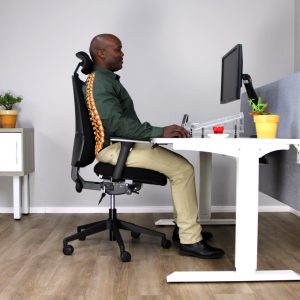
What is an orthopedic office chair?
Ergonomic and orthopedic office chairs are very similar. What are the major differences and which is best?
We are all different and no two people have the exact same body shape and size. An office chair that is comfortable for one person, may be totally uncomfortable for someone else. To accommodate our different body shapes, the design of modern office chairs includes greater adjustability. Initially, this adjustability was limited to the seat height, and while this was a huge step towards greater comfort, it does not go far enough. Today, high-end office chairs are fully adjustable and can be altered to accommodate virtually every body shape and size. Typical features of modern office chairs include multi-adjustable armrests, fully adjustable lumbar supports, seat and backrest angles, seat depth and finally a head or neck rest. History of the office chair.
Having so many adjustable functions reduces, and may even prevent health problems that are commonly caused by sitting on a chair that doesn’t suit or fit your body. How to adjust your office chair to prevent back pain.
As explained by the Victoria Department of Health, sitting still or in an awkward position for long periods, can lead to cardiovascular, circulatory and musculoskeletal problems such as pain in your lower back, neck and shoulders. This can lead to the swelling of nerves and tendons that can cause pain in your elbows and arms. A fully adjustable office chair that includes a head rest, will not only alleviate some of these posture related health issues, but also help you achieve optimum comfort and improved focus, which will result in you being more productive.
Below are the main functions of modern ergonomic office chairs and some pointers on how to use their adjustability to suit your body. What is an ergonomic chair? Take time to know your chair, and understand the functions of the various knobs and levers before you start adjusting your office chair. For more details, see How to setup your office chair – a quick and easy guide.
Chairs that do not move with your body or are ‘locked’ into a fixed position, are static. Sitting statically for extended periods often leads to muscular pain in your back, neck and shoulders. By constantly stimulating these muscles and increasing the blood flow through them, such pain can be reduced. This is achieved when an office chair is fitted with a mechanism that allows Dynamic Sitting.
Modern office chairs like the Alya (pictured), are fully adjustable, including seat & backrest height and angle, armrests, and neck or headrest. With the Alya, Dynamic Sitting is achieved by the inclusion of a synchro mechanism.
Seat height is critical. When you adjust the height of your chair, your feet should be flat on the floor with your knees slightly below the level of your hips. What is the correct height for my desk, computer monitor and office chair?

Seat height adjustment
Left: Seat height is too low and angle of the elbows is less than 900. Forearms are not parallel to the floor.
Right: Seat is too high and angle of the elbows is greater than 900. Again, forearms are not parallel to the floor. The hunched back typically results in muscular pain in the upper back and shoulders.
A seat slider allows you to move the seat pan backward or forward to suit the length of your thighs.
If you are tall, a chair with a seat slider is highly recommended.
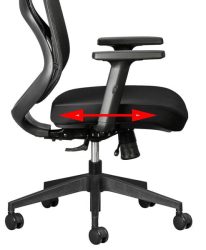
Adjusting the seat angle is only possible on an office chair fitted with a synchronous (synchro) or free-float mechanism.
The mechanical link on a synchronous mechanism simultaneously changes the chair’s backrest and seat angle in a fixed ratio. Synchro mechanisms usually have a 2:1 ratio, meaning that the backrest moves 20 for every 10 of movement in the seat. Most ergonomic office chairs have a synchronous mechanism.
A free-float mechanism allows you to change the seat angle independently from the backrest. Furthermore, the seat can be adjusted to a forward sloping position which reduces the disc pressure in the lumbar region of your back. All orthopedic office chairs have a free-float mechanism. What is an orthopedic office chair?
The free-float motion of either a synchro or free-float mechanism stimulates the muscles in your back and legs which improves blood circulation and reduces muscular pain commonly caused by static sitting.
The seat angle on a free-float mechanism can be set at a negative tilt or forward slope. This forward slope is typically limited to about 50.
According to Occupational Safety and Health Administration (OSHA), a forward sloping seat helps increase blood flow to the lower extremities and at the same time reduces the pressure in the discs of the lower back.
An office chair with a fully adjustable backrest allows you to change the angle between your torso and thighs anywhere from about 90 to 1100. The backrest can typically be locked in any position within this range. It is recommended to keep the backrest in a free-float (rocking) motion to promote continuous support as you sit and move in the chair.
The backrest angle and backrest tension adjustments go hand-in-hand. The ideal tension allows you to easily recline back in your chair while there is still enough resistance to support your back. Some chairs have a self-tensioning feature built into the mechanism which will automatically tension the backrest according to your body weight.
An adjustable lumbar support allows you to position the lumbar pad to fit the curvature of your spine.
Typically, the lumbar support is adjustable in both it’s vertical and horizontal position.
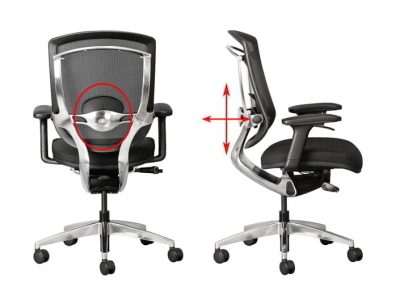
Some office chairs have a fully adjustable backrest. These backrests can be raised or lowered to position them so that they support the natural curvature of your spine.
Adjustable arms will allow you to customise the height and/or distance between the arms as well as the position of the arm pads to suit your body. What is the difference between office chair armrests?
When sitting on the chair, your arms should be parallel to the floor and your elbows bent at about 900.
Arm pads that move forward, backwards and pivot inwards will provide you with correct forearm positioning for better support and comfort.
Note: Armrests are task dependent and not always necessary.

Not all ergonomic office chairs have them and not every person requires a neck or headrest.
Adjustable neck rests are generally not used continuously. Typically, they are only used to support your neck and shoulders when you want to relax or to help reduce stress and stiffness in your neck, back and shoulders.
Many of the desk chairs that we have on sale include an adjustable headrest.
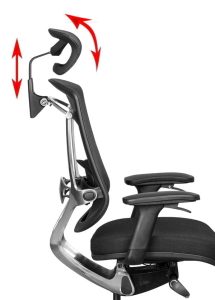
Headrests or neck rests can be a great ergonomic addition to your office chair. Select a chair where both the height and angle of the headrest can be suitably adjusted. An office chair headrest that is not suited to your body can cause more harm than good. This is especially so if it forces your head into a position that results in muscular pain.
When buying a new office chair, look for one that is fully adjustable. Doing so is a smart investment that will not only offer maximum benefits for your health, but will also improve your productivity. How do I choose the right ergonomic desk chair for me?
Contact us for more information on our business furniture solutions.

Ergonomic and orthopedic office chairs are very similar. What are the major differences and which is best?
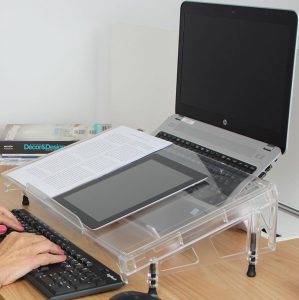
One of the best ergonomic accessories you can get is a document holder.

Although the upfront cost of ergonomic office chairs may seem high, over their lifespan they are a low-cost and smart investment.


